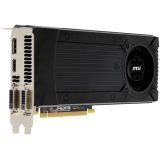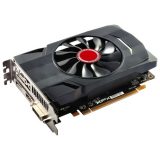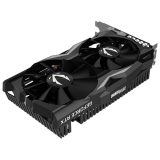 When it comes to building a new gaming PC or upgrading your current rig so it can handle the latest and most graphics-intensive titles on the market, a graphics card is the most important component…even more important than the CPU. But, with all the brand names, sub-brands, model numbers and overclocked models, how can you find the best purchase choice for your budget? I’ll try and make things a little easier on you, by giving you a few tips on how to find the right graphics card for your computer.
When it comes to building a new gaming PC or upgrading your current rig so it can handle the latest and most graphics-intensive titles on the market, a graphics card is the most important component…even more important than the CPU. But, with all the brand names, sub-brands, model numbers and overclocked models, how can you find the best purchase choice for your budget? I’ll try and make things a little easier on you, by giving you a few tips on how to find the right graphics card for your computer.
What is a graphics card?
 Let’s make sure we have the basics covered before we get into the nitty gritty details. Basically, a graphics card (or video card) translates the information that your PC is working on into images and then sends those images to a display. And, as one would expect, the more powerful the graphics processing unit (GPU), the faster that information can be displayed, and the better your gaming experience will be overall.
Let’s make sure we have the basics covered before we get into the nitty gritty details. Basically, a graphics card (or video card) translates the information that your PC is working on into images and then sends those images to a display. And, as one would expect, the more powerful the graphics processing unit (GPU), the faster that information can be displayed, and the better your gaming experience will be overall.
There are two main companies producing graphics card GPUs these days, AMD and Nvidia. But, while they are the major players, they do licence out their hardware to other manufacturing companies, such as ASUS, EVGA, Msi and more. These companies typically offer different cooling, overclocking and software on their graphics cards. So, while the GPUs may be the same model across different brands’ graphics cards, the cooling and software (and, thus, performance) can vary.
Do your research and set a budget
 Before you step foot in a store or start looking for graphics cards online, make sure you’ve considered a few things. First, what is your budget? Make sure you set a budget and keep to that budget. Graphics cards are expensive components, so make sure you have the cash for the level of card you need, and don’t overspend for something you won’t need. For example, if you don’t play games that require wicked awesome graphics, then you won’t need to spend as much for your graphics card.
Before you step foot in a store or start looking for graphics cards online, make sure you’ve considered a few things. First, what is your budget? Make sure you set a budget and keep to that budget. Graphics cards are expensive components, so make sure you have the cash for the level of card you need, and don’t overspend for something you won’t need. For example, if you don’t play games that require wicked awesome graphics, then you won’t need to spend as much for your graphics card.
The second thing to do, is ensure you know about compatibility. The last thing you want to do is get a new card, open your PC case and find out the card is a couple of inches too big for your case. Or, how about finding out your power supply can’t handle that snazzy new card? Some cards also need more slots than others, too. Do you have the extra slots and space? Always make sure you are aware of the size constrains, slot use and power needs of whatever card you have your eye on, and whether your PC can currently handle them.
What kind of monitor will you use?
Another big consideration is what display configuration you’ll be using. The majority of mainstream graphics cards can handle gaming at 1080p resolutions and 30-60 fps. However, if you have, say, a 4K monitor, then you’re going to need a graphics card that is a little more high-end. The same goes for if you are planning on running a multiple monitor setup. While a graphics card may absolutely rock every title with gorgeous graphics on a single 1080p monitor, that same graphics card might choke and deliver abysmal performance with two HD gaming monitors. Also, if you are going to run two monitors, make sure the graphics card you’re looking at does indeed support the kind of configuration by having multiple HDMI ports. Also, some monitors have HDMI, others use DisplayPort and some older units only have DVI. Make sure the card has the connectors you need for your monitor(s), so you don’t have to buy any adapters.
Is the graphic card VR ready?
 As this is 2019 and virtual reality is quite the big thing right now, you may want to consider if you want to jump into that particular technology. If you do want to enjoy 360-degree, head-tracked video gaming, where you are right inside the action and digital world, then yeah, you’ll need a graphics card that can handle it. The last thing you want to do is buy a graphics card and expect it to work with VR, only to be supremely disappointed later. That’s what happened to a friend of mine. He shelled out a ton of cash building a new PC, and then bought an Oculus Rift package, then when he tried to get it to work, he found the graphics card was woefully inadequate for VR, and he had to go buy a new card. It ended up costing him a lot more in the end because he wasn’t thinking about what he really wanted the card for.
As this is 2019 and virtual reality is quite the big thing right now, you may want to consider if you want to jump into that particular technology. If you do want to enjoy 360-degree, head-tracked video gaming, where you are right inside the action and digital world, then yeah, you’ll need a graphics card that can handle it. The last thing you want to do is buy a graphics card and expect it to work with VR, only to be supremely disappointed later. That’s what happened to a friend of mine. He shelled out a ton of cash building a new PC, and then bought an Oculus Rift package, then when he tried to get it to work, he found the graphics card was woefully inadequate for VR, and he had to go buy a new card. It ended up costing him a lot more in the end because he wasn’t thinking about what he really wanted the card for.
Other considerations
Some other considerations you may have when investing in a new graphics card is whether the card works better with certain motherboards or if it is designed to be paired with a monitor that supports specific tech from a specific brand, for example, G-Sync and Free-Sync.
Remember, you are not just buying a graphics card for right now. The card you buy will be in your computer, barring any unforeseen issues or early tech demise, for a couple of years, at least. So, make sure you are thinking about future-proofing your rig by getting the best card you can afford, that meets your immediate needs and any potential ones you can think of.
So, did I give you enough to think about? Do you feel you know enough to buy a graphics card for your computer now? Do you prefer graphics cards from Nvidia or AMD? Which will you buy? Why? Make sure to let me know your opinions in the comment section below, and don’t forget to check out all the graphics cards available online at Best Buy.



